The saying “records are made to be broken” fueled a five-year aspiration to challenge place-to-place cycling records. Despite years of contemplation, the push to actually attempt these records only came after an unexpected setback: a broken leg in December 2021. This injury, while unfortunate, became the catalyst. Recovery became intertwined with a new goal – not just healing, but building the ultimate machine to conquer these records. The biggest hurdle, surprisingly, wasn’t physical fitness, but the lack of a truly optimized time trial bike.
2022 transformed into a dual project: rehabilitation and the meticulous creation of the best bike possible for record attempts. This article is the latest installment in our “building the best bike for” series, detailing the components and rationale behind what we consider a near-perfect setup for tackling time trial challenges.
Ultimately, the year culminated in attempts at three records. One was broken, another narrowly missed, and the third didn’t even reach the starting line, highlighting the unpredictable nature of record attempts and the crucial role of equipment.
This particular “best bike” build differs slightly from previous iterations in this series. While earlier builds focused on specific events or demands, a time trial bike aimed at endurance records necessitates greater adaptability. Courses vary, durations stretch, and the relentless march of aerodynamic technology means today’s cutting-edge innovation might be superseded tomorrow. Therefore, consider this not the definitive “best bike” for time trialing, but rather a highly refined configuration within an ever-evolving quest for speed.
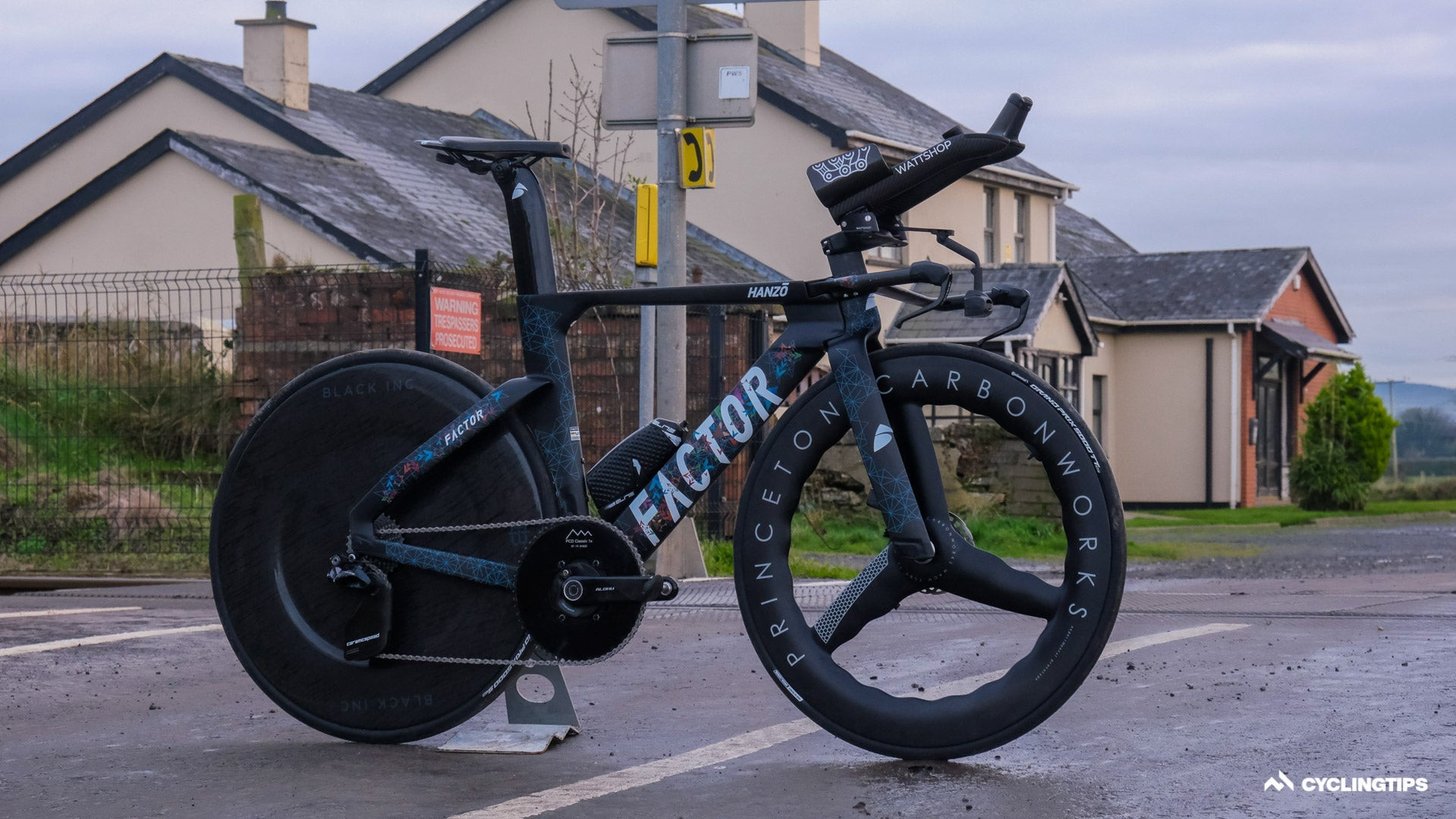 Factor Hanzo time trial bike showcasing its aerodynamic frame design and deep profile wheels
Factor Hanzo time trial bike showcasing its aerodynamic frame design and deep profile wheels
At the core of any exceptional bike build lies the frame. For record attempts spanning diverse distances and terrains, the chosen frame needed to be more than just aerodynamic; it required significant adjustability. The Factor Hanzo emerged as the ideal candidate. Its design is a masterclass in modern time trial technology: an incredibly narrow and deep head tube, truncated airfoil tubing, an external fork steerer seamlessly integrated with a mono riser front end, widely set fork legs, dropped seat stays, and the stopping power of disc brakes. The Hanzo embodies a comprehensive approach to aerodynamic efficiency and rider adaptability.
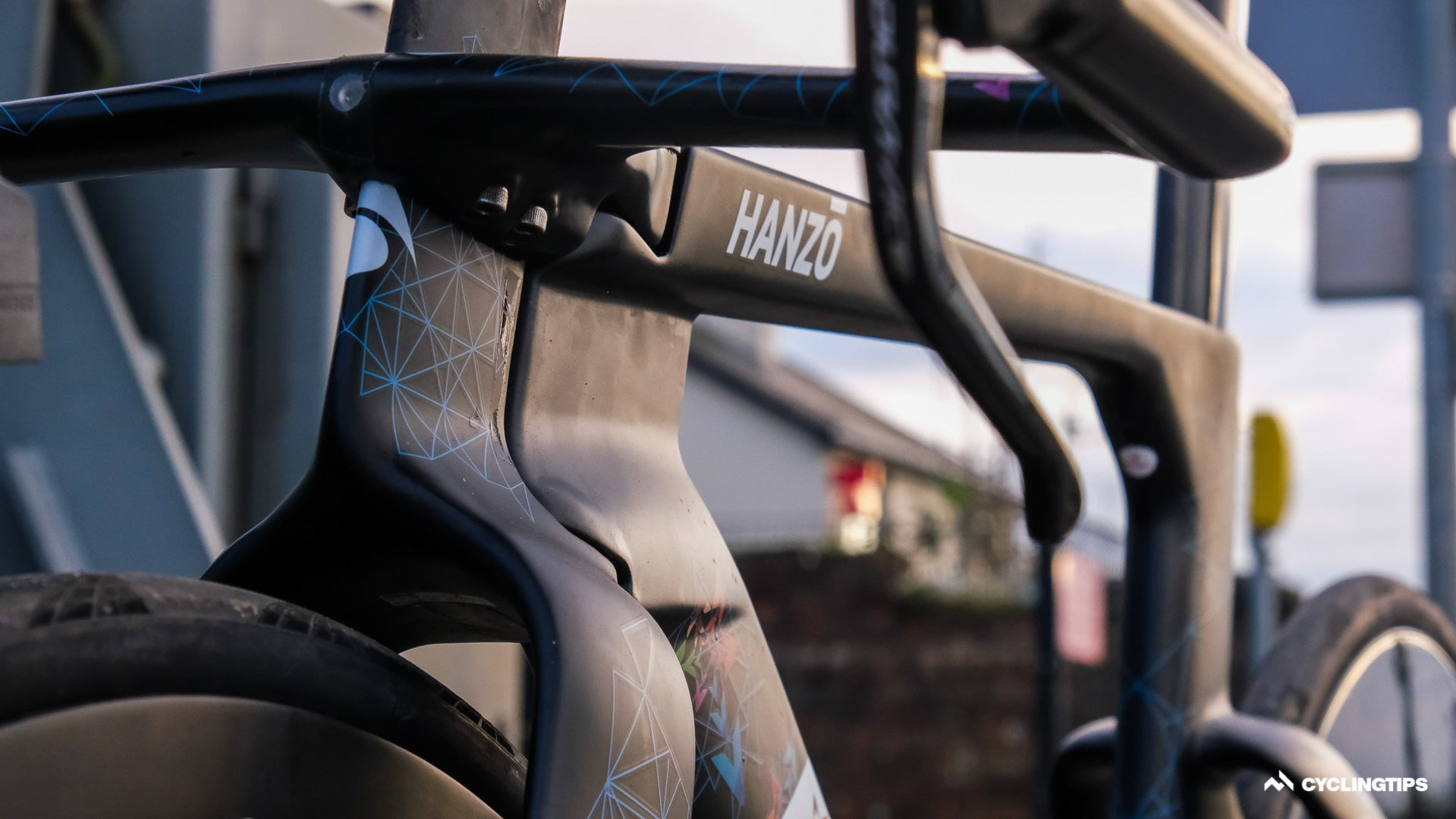 Close-up highlighting the Factor Hanzo frame's narrow head tube and integrated front end
Close-up highlighting the Factor Hanzo frame's narrow head tube and integrated front end
The Factor Hanzo frame presents a compelling blend of narrow and wide profiles, seamlessly integrating adjustability without compromising aerodynamic performance. Surprisingly, it also delivers handling far superior to what one might expect from a pure time trial machine.
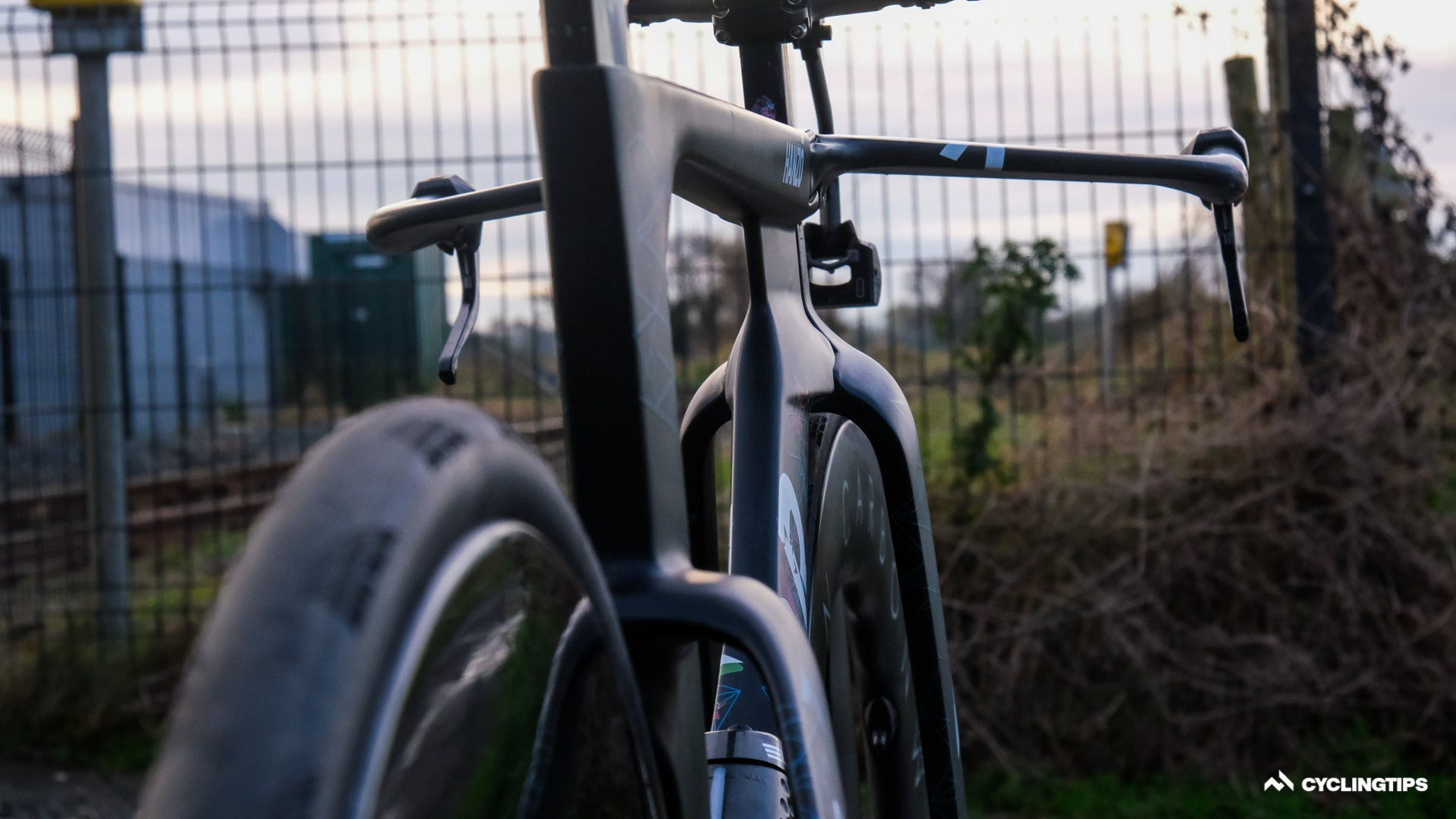 Detail shot of the Factor Hanzo's truncated tubing, showcasing its aerodynamic shaping
Detail shot of the Factor Hanzo's truncated tubing, showcasing its aerodynamic shaping
Truncated tubing is a key aerodynamic feature of the Factor Hanzo, minimizing drag while maintaining structural integrity and stiffness.
 Rear view of the Factor Hanzo frame, emphasizing the dropped seat stays and aerodynamic profile
Rear view of the Factor Hanzo frame, emphasizing the dropped seat stays and aerodynamic profile
The seat stays on the Hanzo are meticulously sculpted, almost resembling a rear wing, further contributing to the bike’s overall aerodynamic efficiency.
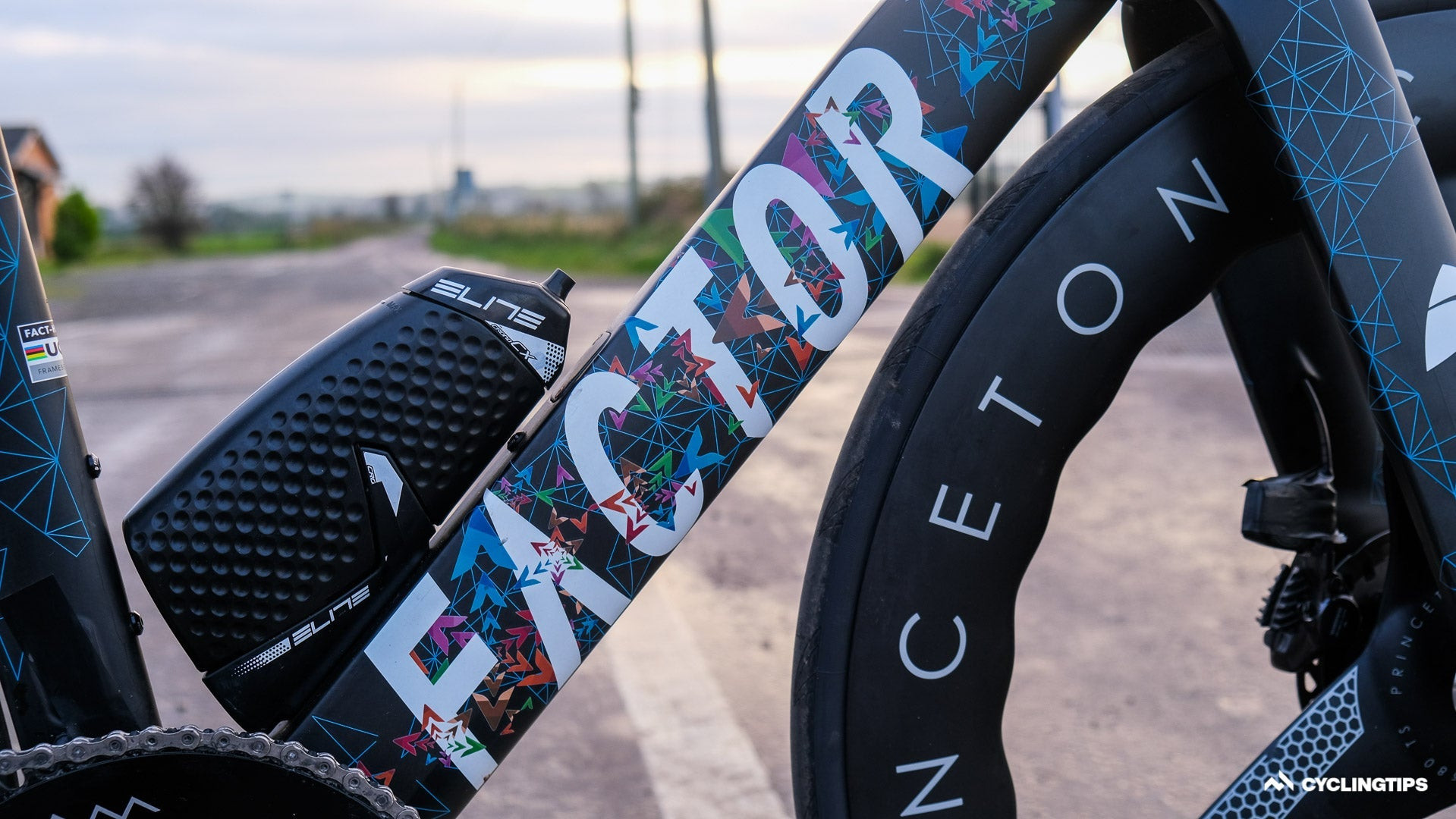 Side view of the Factor Hanzo frame, pointing out the downtube and front wheel clearance
Side view of the Factor Hanzo frame, pointing out the downtube and front wheel clearance
If there were one aspect to refine on the Hanzo frame, it would be to bring the downtube closer to the front wheel, potentially further reducing aerodynamic drag in this critical area.
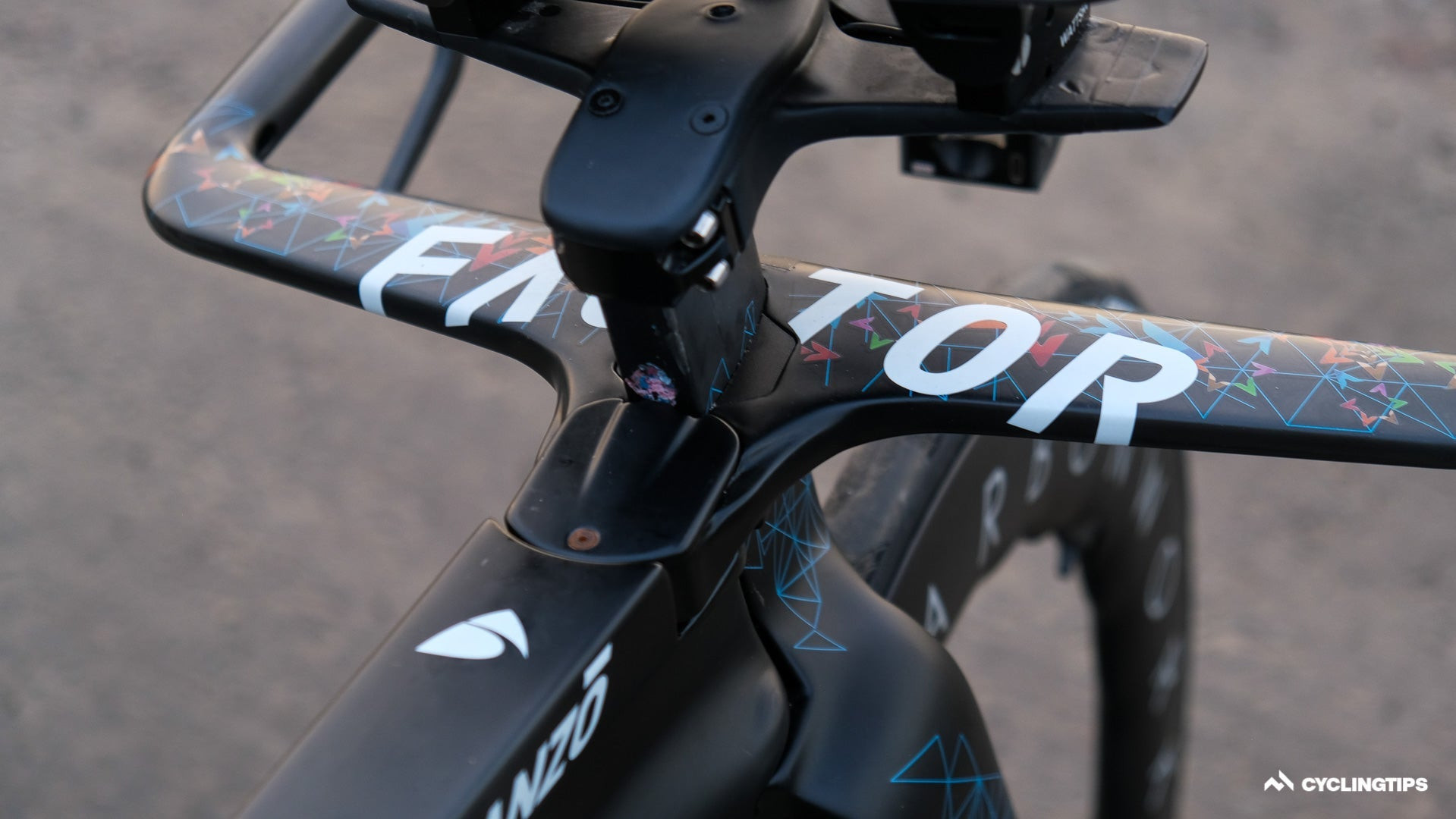 Front view of the Factor Hanzo base bar, showing its clean lines and integrated design
Front view of the Factor Hanzo base bar, showing its clean lines and integrated design
The base bar of the Factor Hanzo is designed for minimal frontal area, contributing to the bike’s overall aerodynamic profile and clean aesthetics.
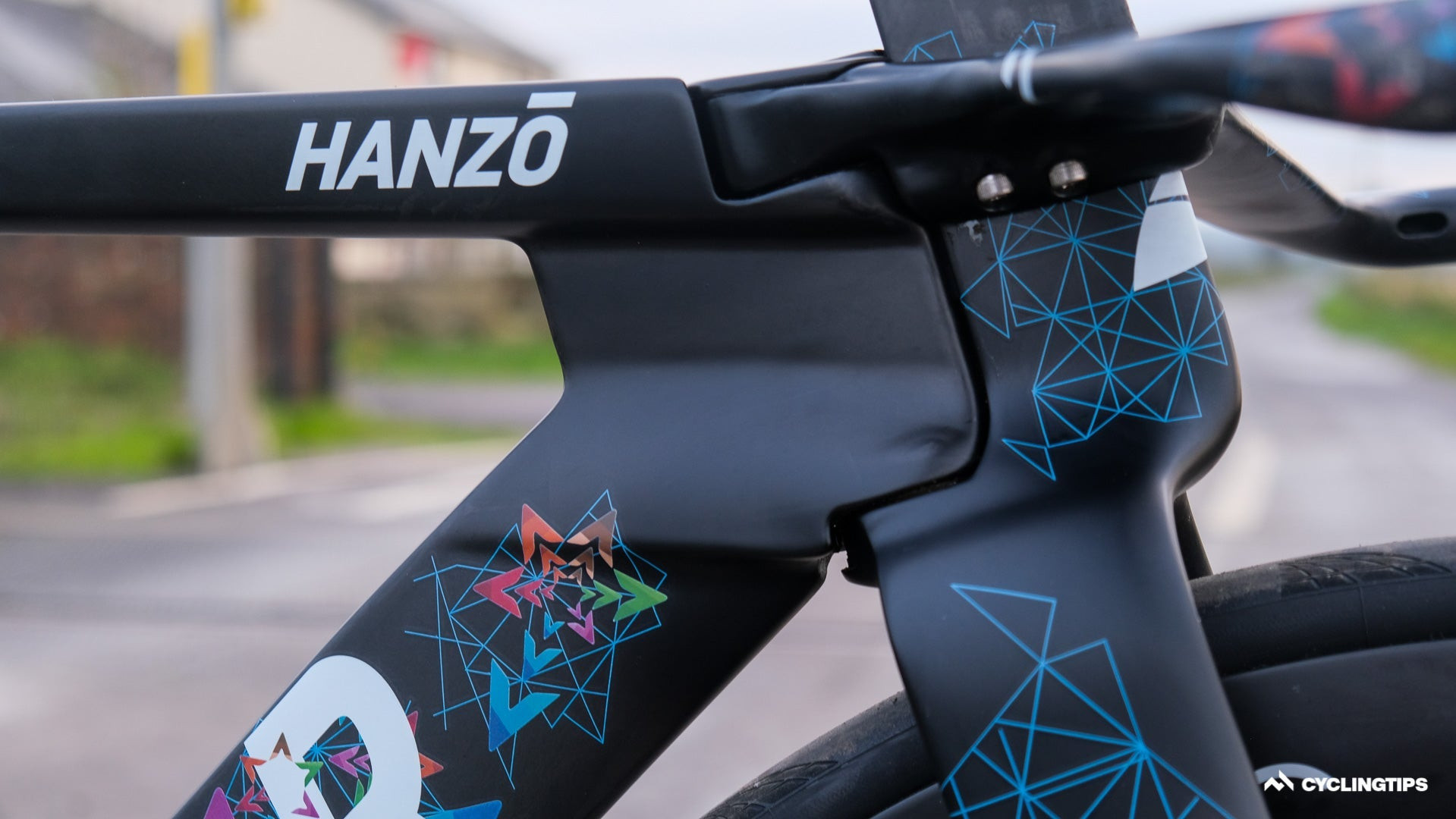 Close-up of the Factor Hanzo fork steerer and narrow headtube junction, highlighting the aerodynamic shaping
Close-up of the Factor Hanzo fork steerer and narrow headtube junction, highlighting the aerodynamic shaping
The fork steerer, resembling a nosecone, flows seamlessly into the narrow headtube, creating an exceptionally deep and aerodynamically optimized front end on the Factor Hanzo.
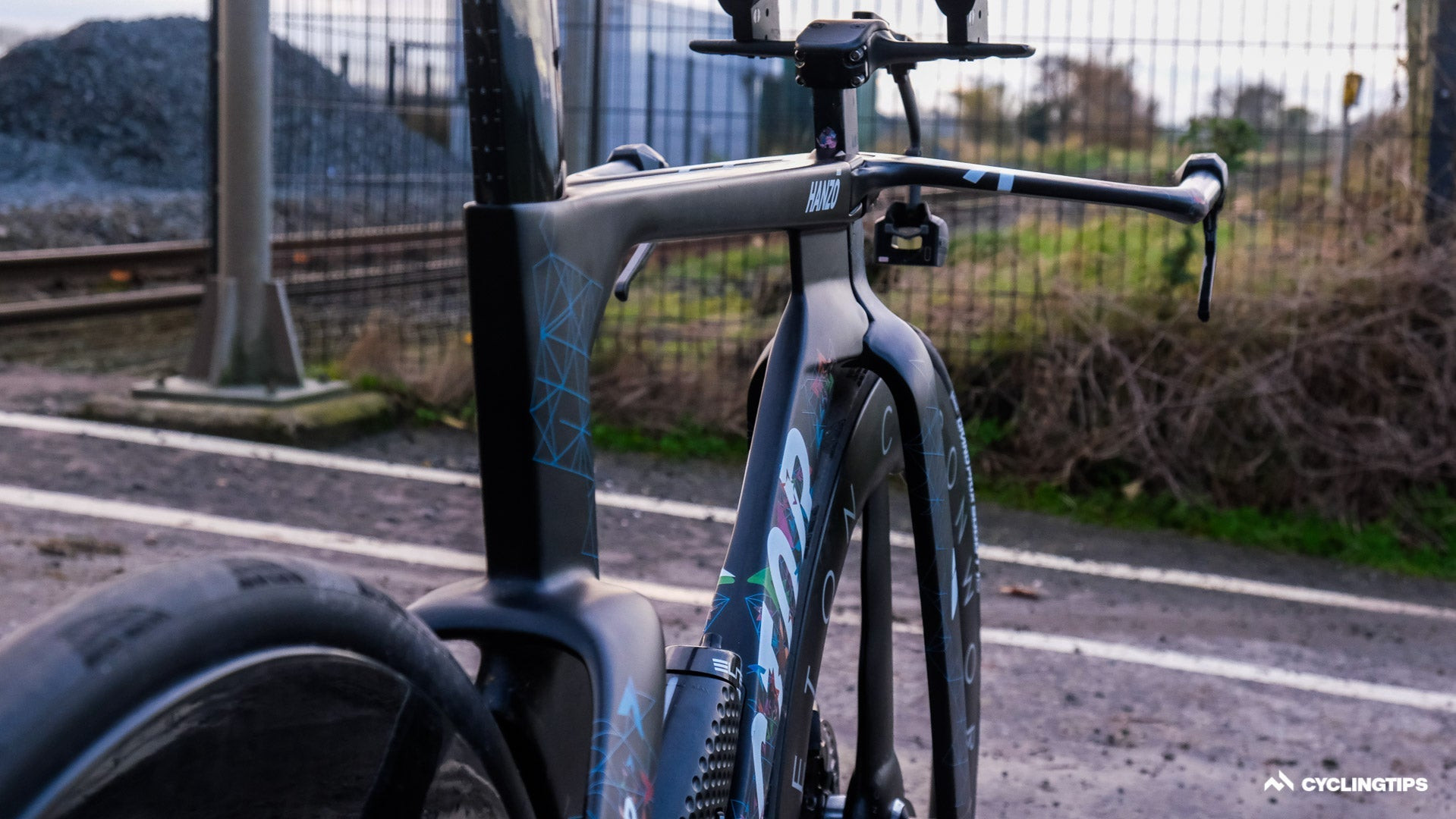 Angle view emphasizing the narrowness of the Factor Hanzo's head tube, showcasing its aerodynamic advantage
Angle view emphasizing the narrowness of the Factor Hanzo's head tube, showcasing its aerodynamic advantage
This angle provides a clearer perspective on just how remarkably narrow the head tube of the Factor Hanzo is, a key factor in its aerodynamic performance.
 Side profile of the Factor Hanzo bottom bracket area, illustrating its robust and tall design
Side profile of the Factor Hanzo bottom bracket area, illustrating its robust and tall design
In contrast to the narrow head tube, the bottom bracket area of the Factor Hanzo is notably tall and robust, ensuring efficient power transfer.
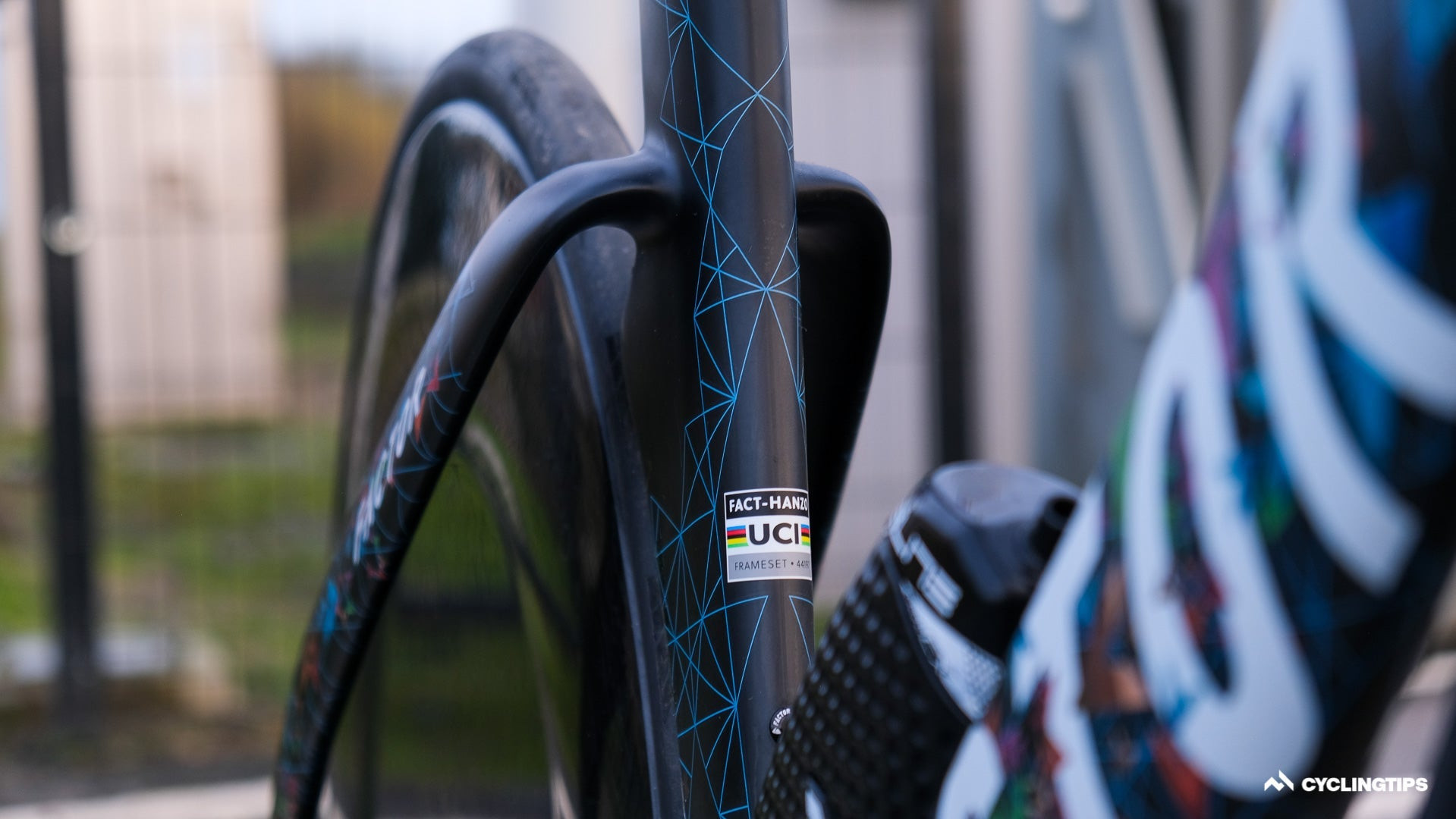 Rear dropout and wide stays of the Factor Hanzo, highlighting UCI legality and stiffness
Rear dropout and wide stays of the Factor Hanzo, highlighting UCI legality and stiffness
The wide-set stays at the rear dropout of the Factor Hanzo are crucial for both UCI legality and providing enhanced frame stiffness.
 Full build of the Factor Hanzo time trial bike, showcasing the Wattshop extensions and Princeton wheels
Full build of the Factor Hanzo time trial bike, showcasing the Wattshop extensions and Princeton wheels
With the frame selected, the focus shifted to optimizing the front end for maximum watt savings. Time trial extensions have undergone a revolution since Greg LeMond’s iconic 1989 Tour de France victory. Modern “skis” not only facilitate a more aerodynamic rider position but also integrate with the rider’s arms, refining the overall aero profile and distributing forearm pressure. Elbow rests have evolved into supportive structures, enabling riders to contort themselves into incredibly aerodynamic shapes. The Wattshop Anemoi extensions embody these advancements, exuding speed even at a standstill.
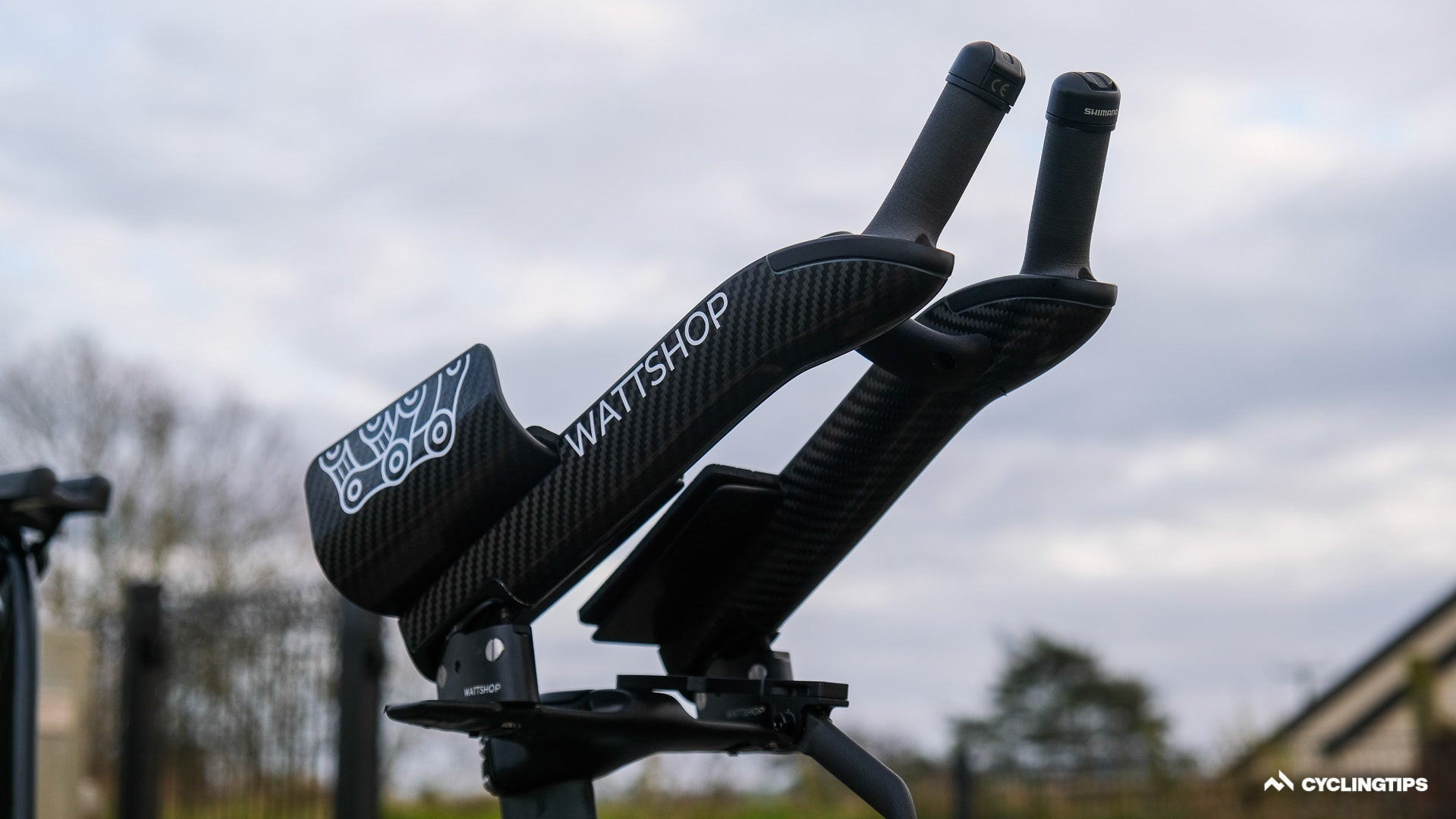 Wattshop Anemoi time trial extensions mounted on the Factor Hanzo, emphasizing adjustability and aerodynamic design
Wattshop Anemoi time trial extensions mounted on the Factor Hanzo, emphasizing adjustability and aerodynamic design
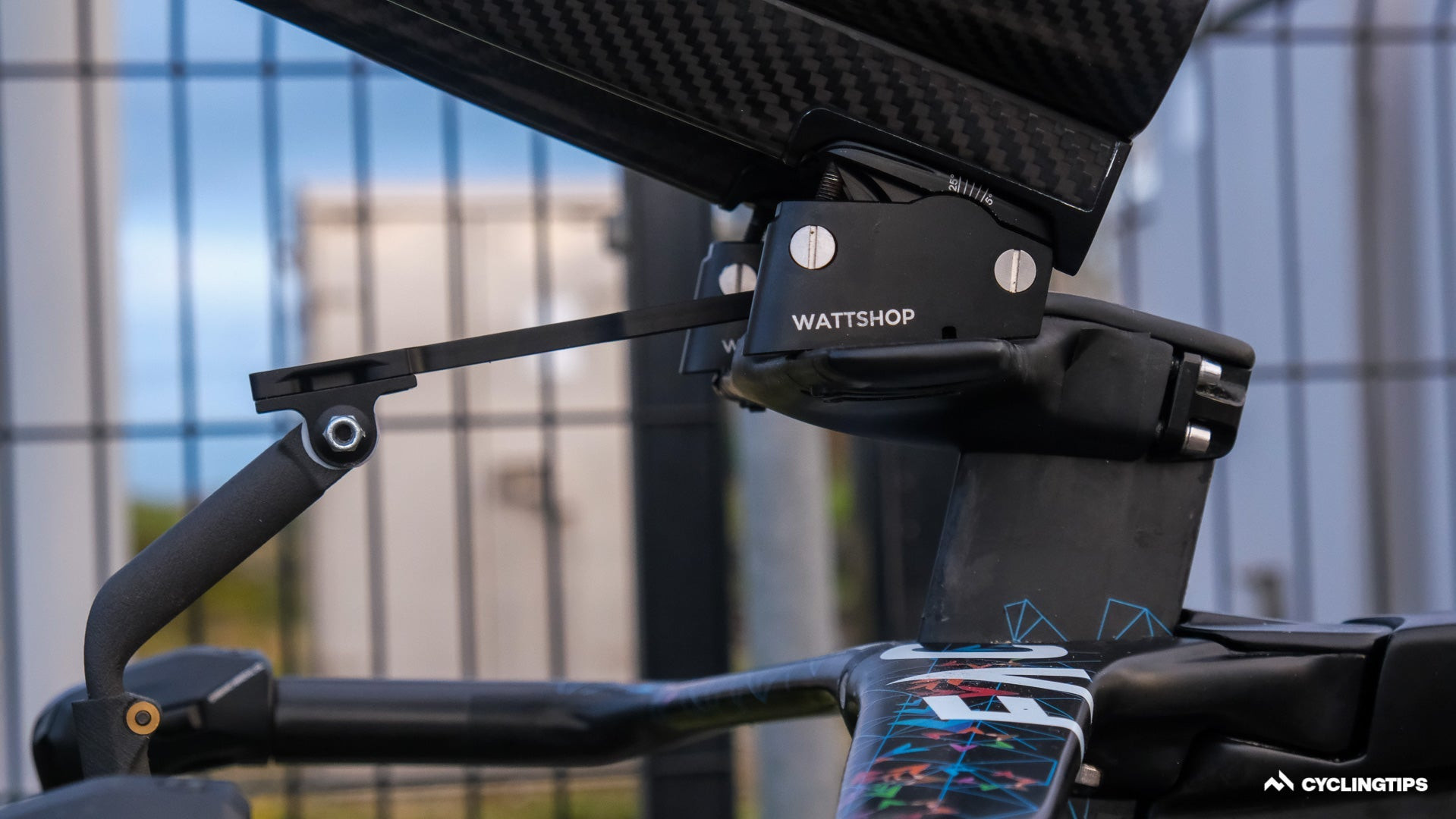 Close-up of the Wattshop angled risers on the Factor Hanzo, showing Di2 cable routing and adjustability
Close-up of the Wattshop angled risers on the Factor Hanzo, showing Di2 cable routing and adjustability
Adaptability remained paramount for various events and distances. The Hanzo fork and Factor base plate combination create a mono-riser system. While intended for a cut-to-length steerer, removing the top cap allows for a vast range of front-end height adjustments, accommodating both aggressive and more relaxed positions. Wattshop angled risers offer precise and straightforward micro-angle adjustments for the aero extensions, ranging from 5 to 25 degrees. These anodized 7075-T6 aluminum risers not only tilt the extensions but also neatly channel Di2 wires through the risers and into the Factor base plate, maintaining a clean aesthetic and aerodynamic advantage.
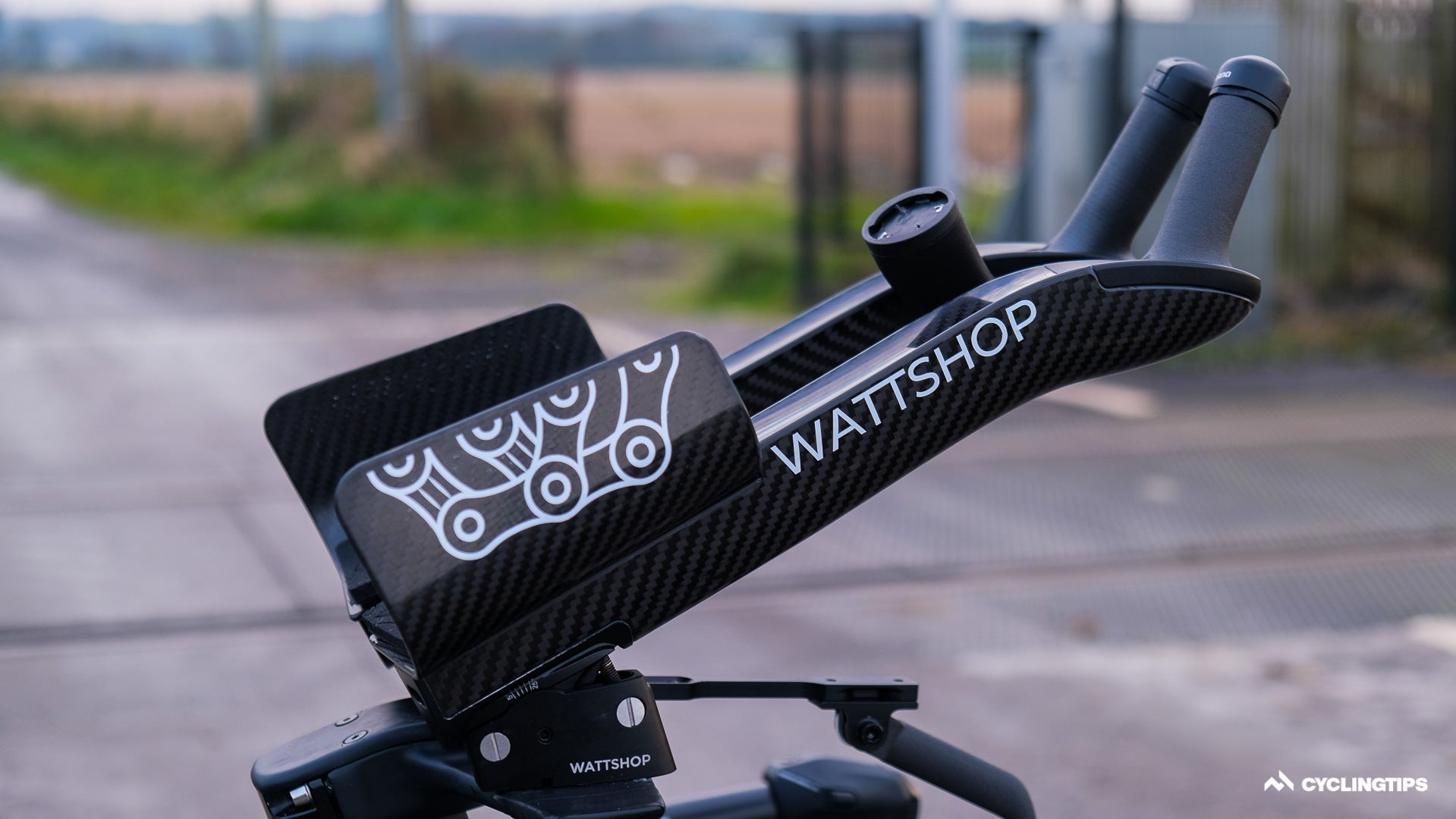 Wattshop Anemoi carbon arm rests on the Factor Hanzo, highlighting their high-sided design for support and aerodynamics
Wattshop Anemoi carbon arm rests on the Factor Hanzo, highlighting their high-sided design for support and aerodynamics
Completing the Wattshop front end are the Anemoi carbon arm rests. Their high-sided design offers superior support, enhanced comfort, and improved aerodynamic integration with the rider’s arms compared to traditional open armrests. The high sides provide a bracing point, aiding in maintaining a compact and aerodynamic position for extended periods.
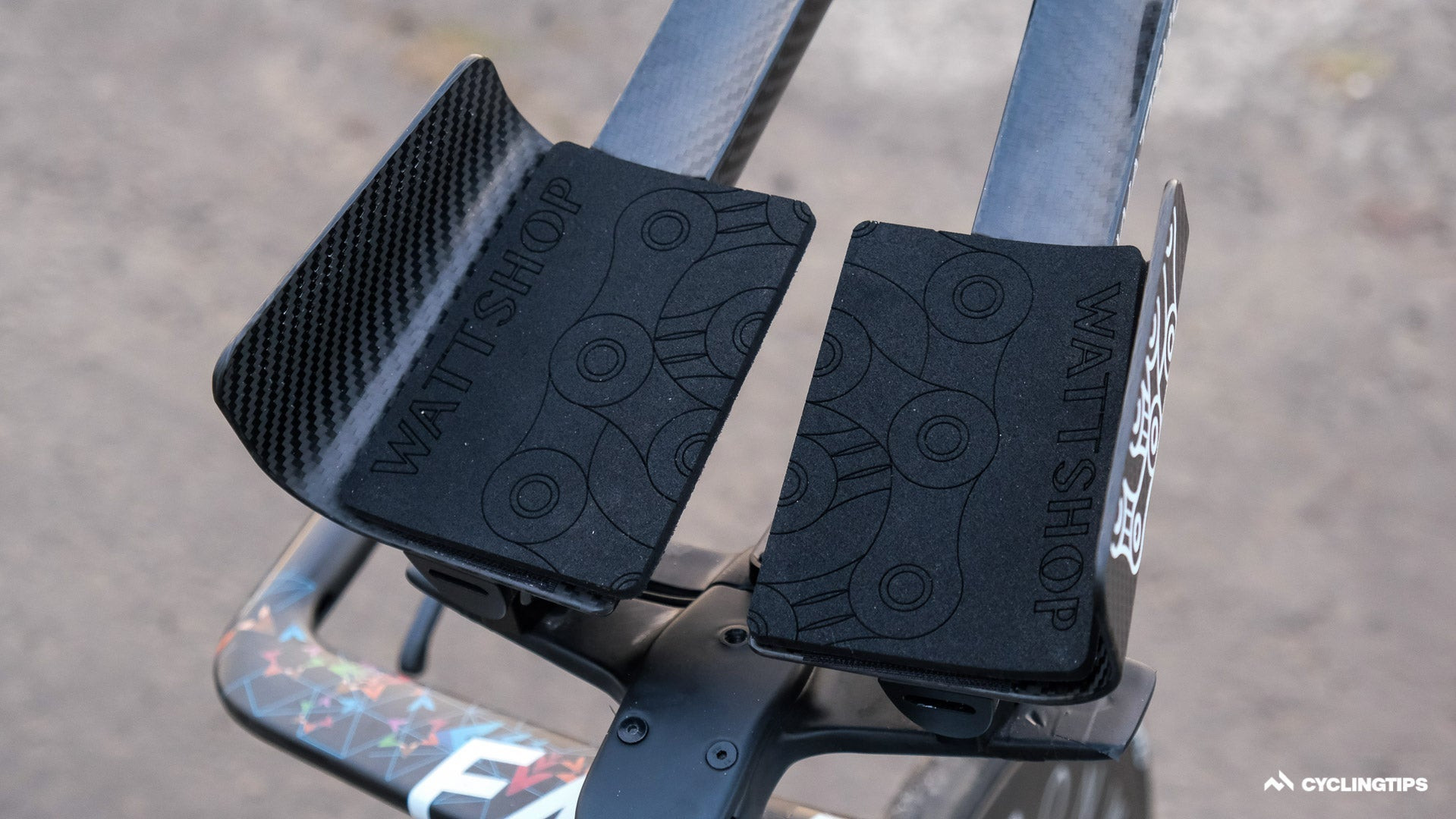 Two-piece Wattshop Anemoi arm rests on the Factor Hanzo, noting UCI compliance and adjustability
Two-piece Wattshop Anemoi arm rests on the Factor Hanzo, noting UCI compliance and adjustability
While available as both one-piece and two-piece setups, the two-piece Anemoi arm rests were chosen for UCI-regulated events and races. The UCI currently prohibits the use of one-piece armrests in competition, making the two-piece version a more versatile choice.
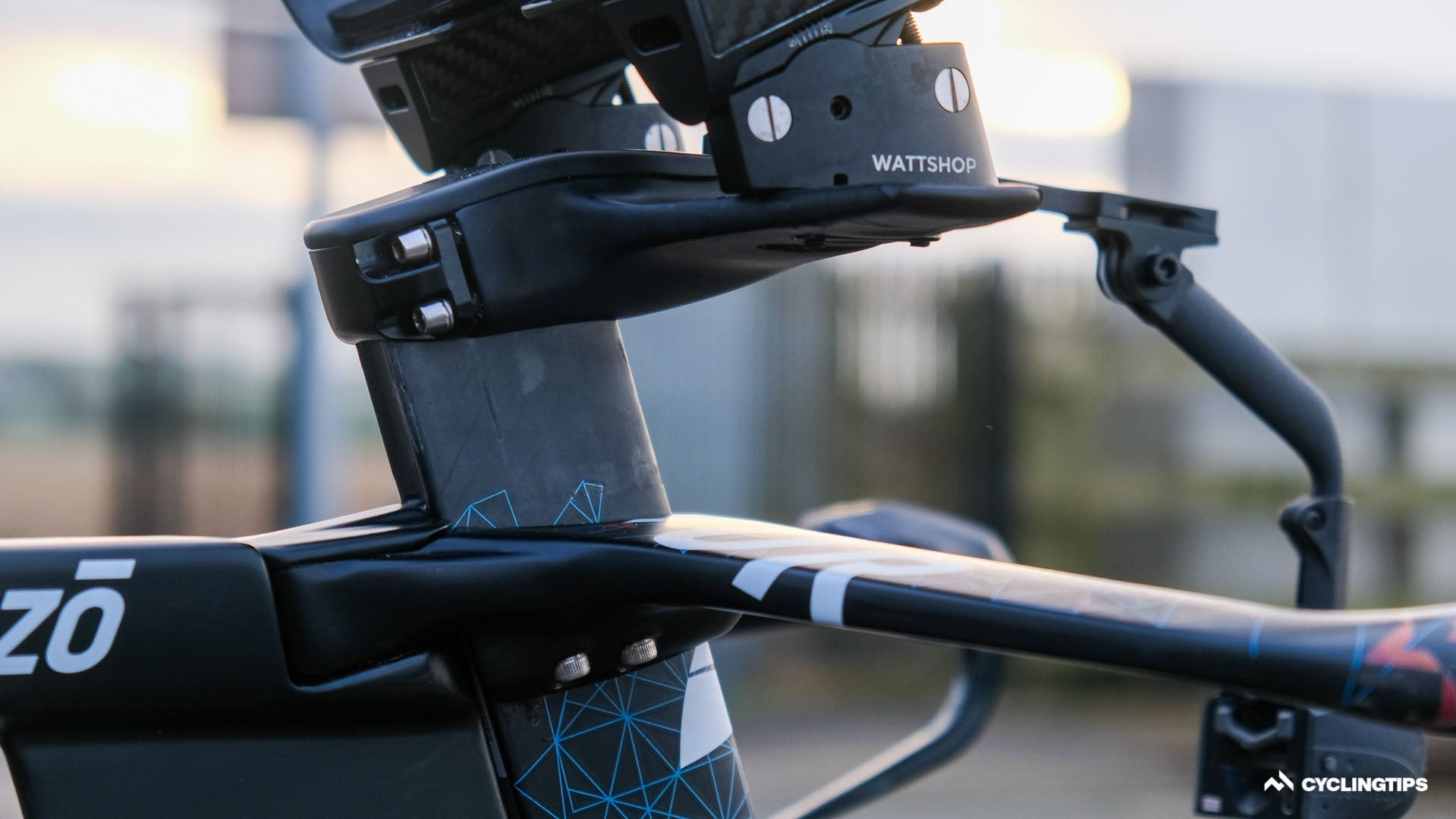 Aerosensor aero meter mounted on the Factor Hanzo, emphasizing data-driven optimization and real-world aero testing
Aerosensor aero meter mounted on the Factor Hanzo, emphasizing data-driven optimization and real-world aero testing
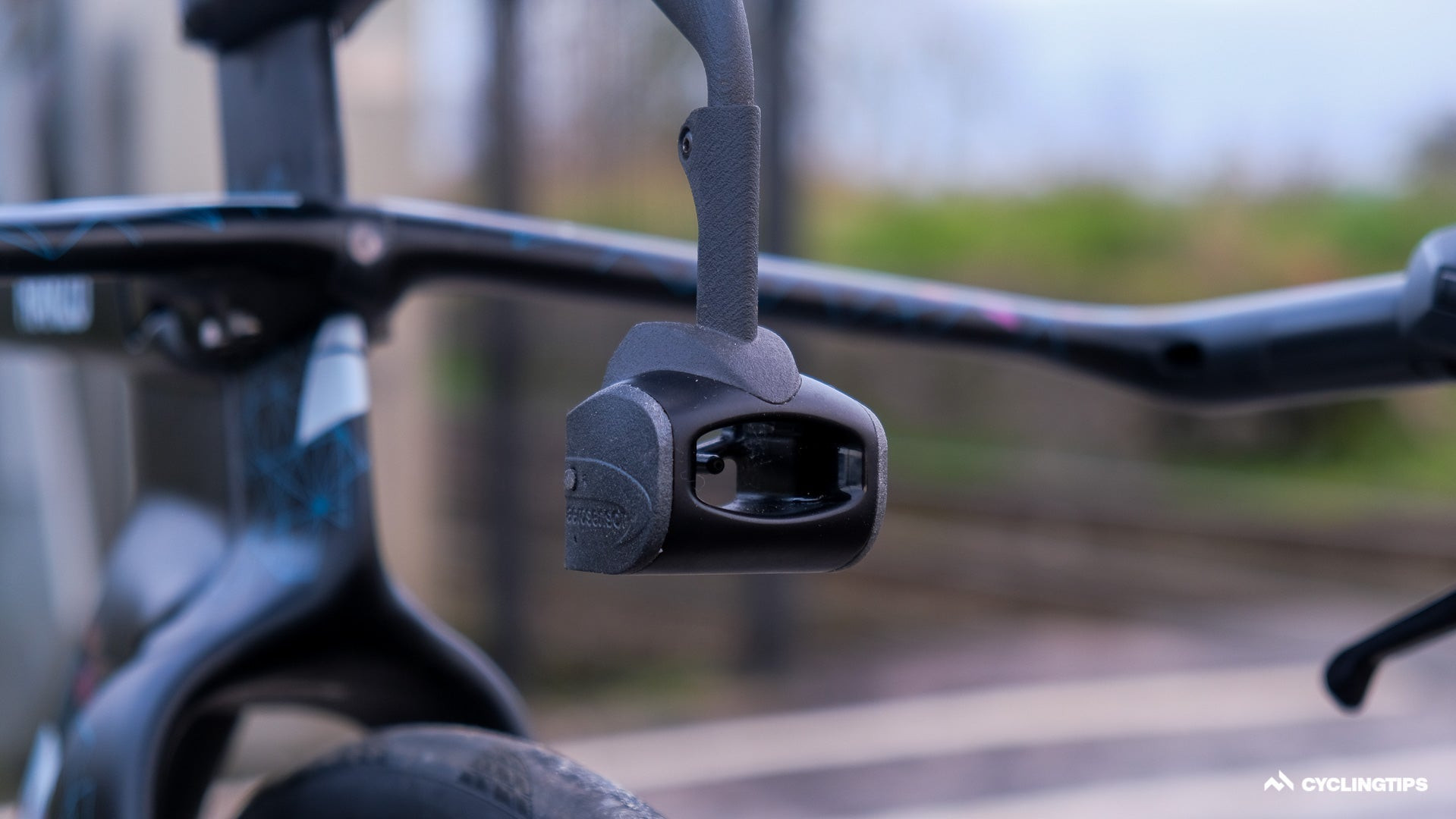 Close-up view of the Aerosensor aero meter, highlighting its compact design and data acquisition capabilities
Close-up view of the Aerosensor aero meter, highlighting its compact design and data acquisition capabilities
No time trial build would be complete without data analysis. The Aerosensor aero meter plays a crucial role, not only in refining the optimal time trial position but also offering a suite of capabilities, including real-world aerodynamic testing and aero mapping of courses. This data-driven approach ensures the best equipment setup for specific conditions and courses.
Deep rim or tri-spoke? Why not both? The Princeton Carbon Works Mach 7580 TS front wheel is a 75/80 mm deep sinusoidal rim tri-spoke marvel. It features a 20.5mm hook-to-hook tire bed, a 27mm external width, and a proprietary integrated one-piece aerodynamic axle. This dream time trial wheel, however, comes at a premium, with a price tag of $2,750 – and that’s just for one front wheel, as noted on Princeton’s product page.
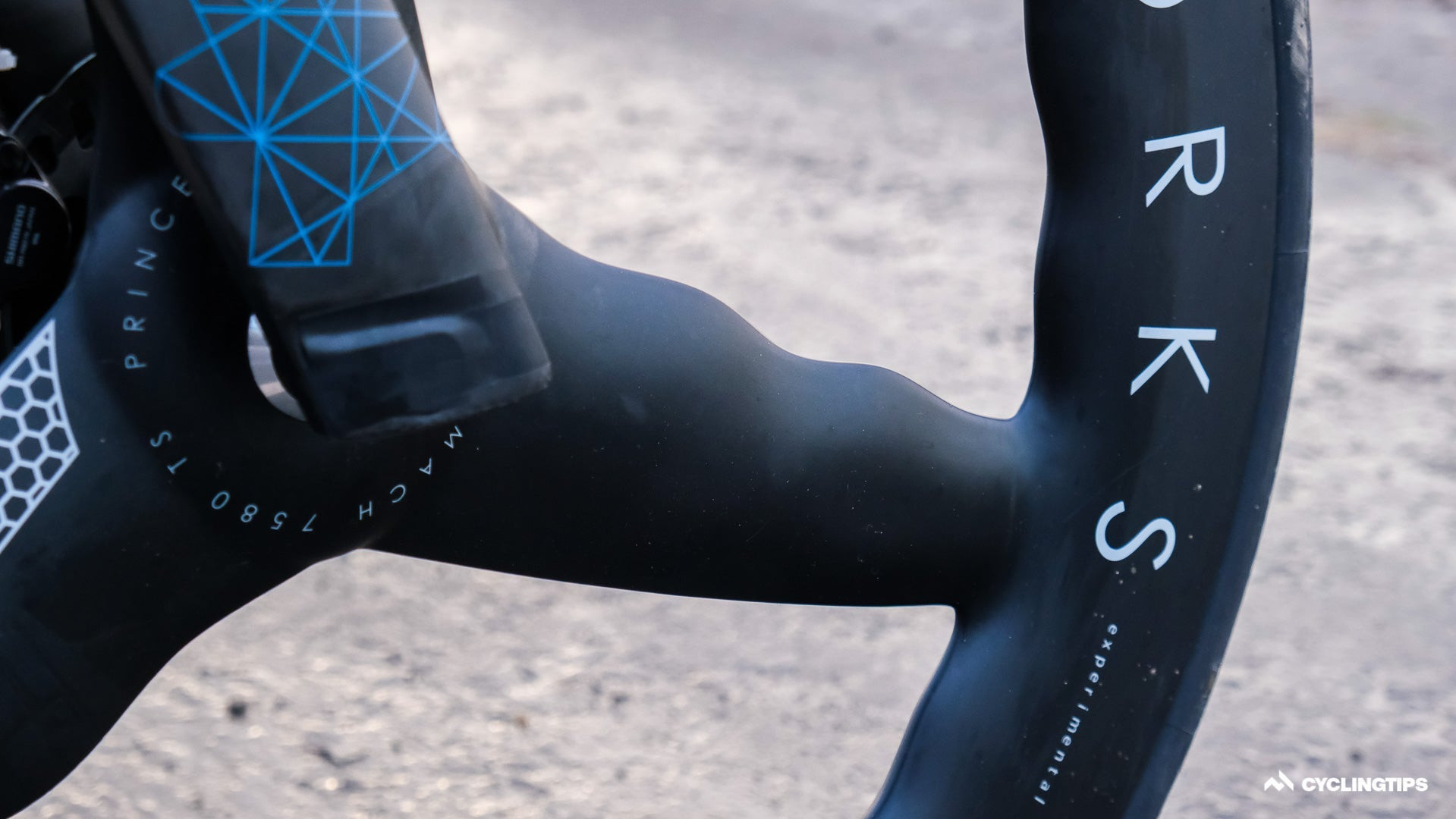 Side view of the Princeton Carbon Works Mach 7580 TS wheel, resembling a shark fin for its aerodynamic profile
Side view of the Princeton Carbon Works Mach 7580 TS wheel, resembling a shark fin for its aerodynamic profile
The Princeton Mach 7580 TS wheel profile resembles a shark fin, designed to slice through the air with minimal resistance.
 Black Inc Zero disc rear wheel on the Factor Hanzo, highlighting its asymmetrical lenticular shape
Black Inc Zero disc rear wheel on the Factor Hanzo, highlighting its asymmetrical lenticular shape
For the rear wheel, the new Black Inc Zero disc, specifically designed to complement the Hanzo frame, was selected. This asymmetrical disc features a lenticular shape and a drive-side only “virtual 100mm” rim, claimed to provide up to 20 watts of “thrust”. Flipping to the non-drive side, the disc exhibits a bulbous lenticular shape, engineered for substantial aerodynamic gains. This asymmetrical design is dictated by the space constraints of the drivetrain on the drive side, resulting in a unique and visually striking appearance.
Fast wheels demand fast tires. Up front, the 25mm Continental GP 5000 TT TDF tire was chosen, offering enhanced aerodynamics and reduced rolling resistance. It’s further optimized with a Silca speed shield for the most marginal of gains.
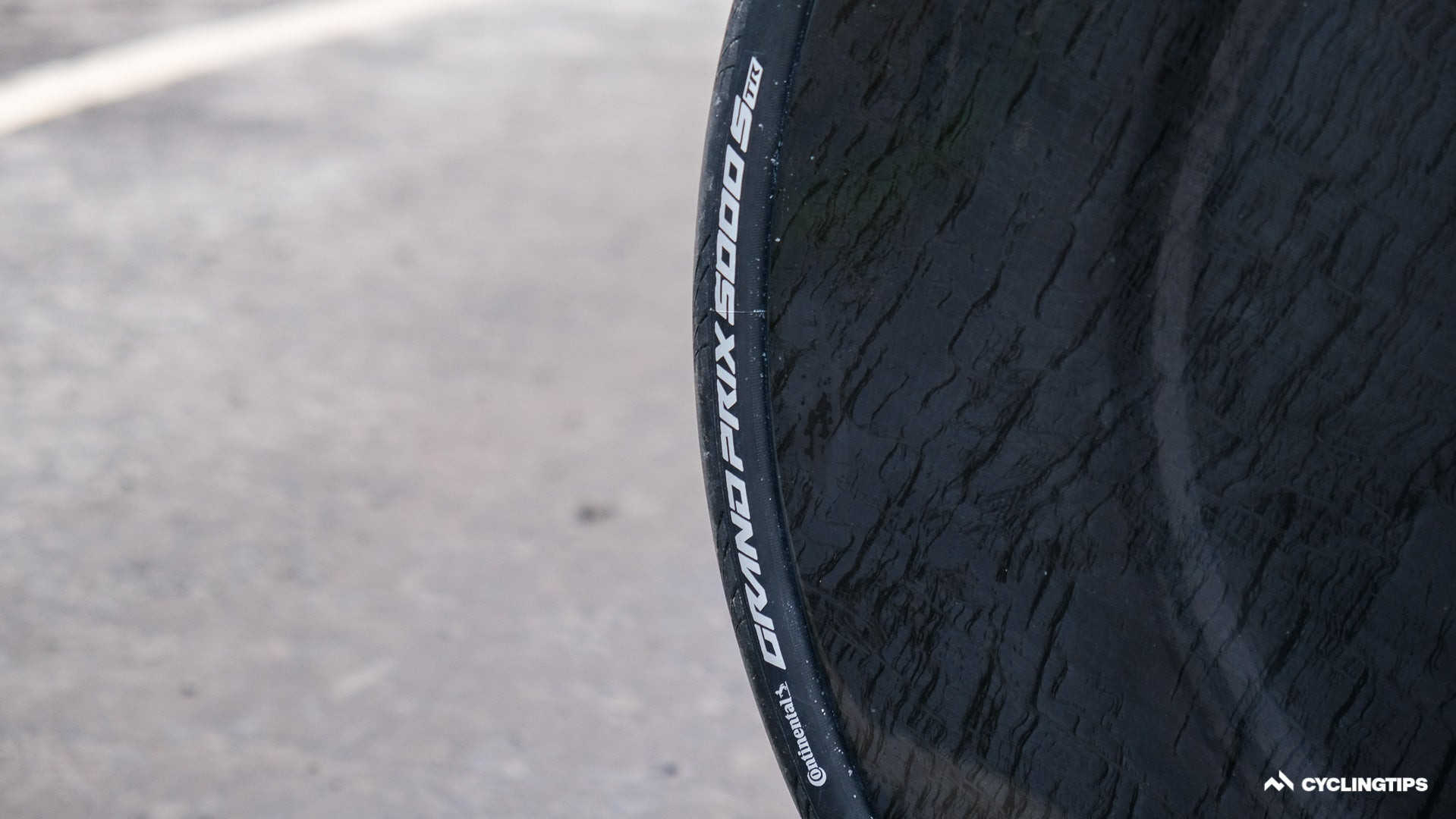 Continental GP 5000 S TR 28mm rear tire on the Factor Hanzo, prioritizing rolling resistance over aerodynamics
Continental GP 5000 S TR 28mm rear tire on the Factor Hanzo, prioritizing rolling resistance over aerodynamics
Paired with a 28mm GP 5000 S TR on the rear, the focus shifts to minimizing rolling resistance where aerodynamics are less critical.
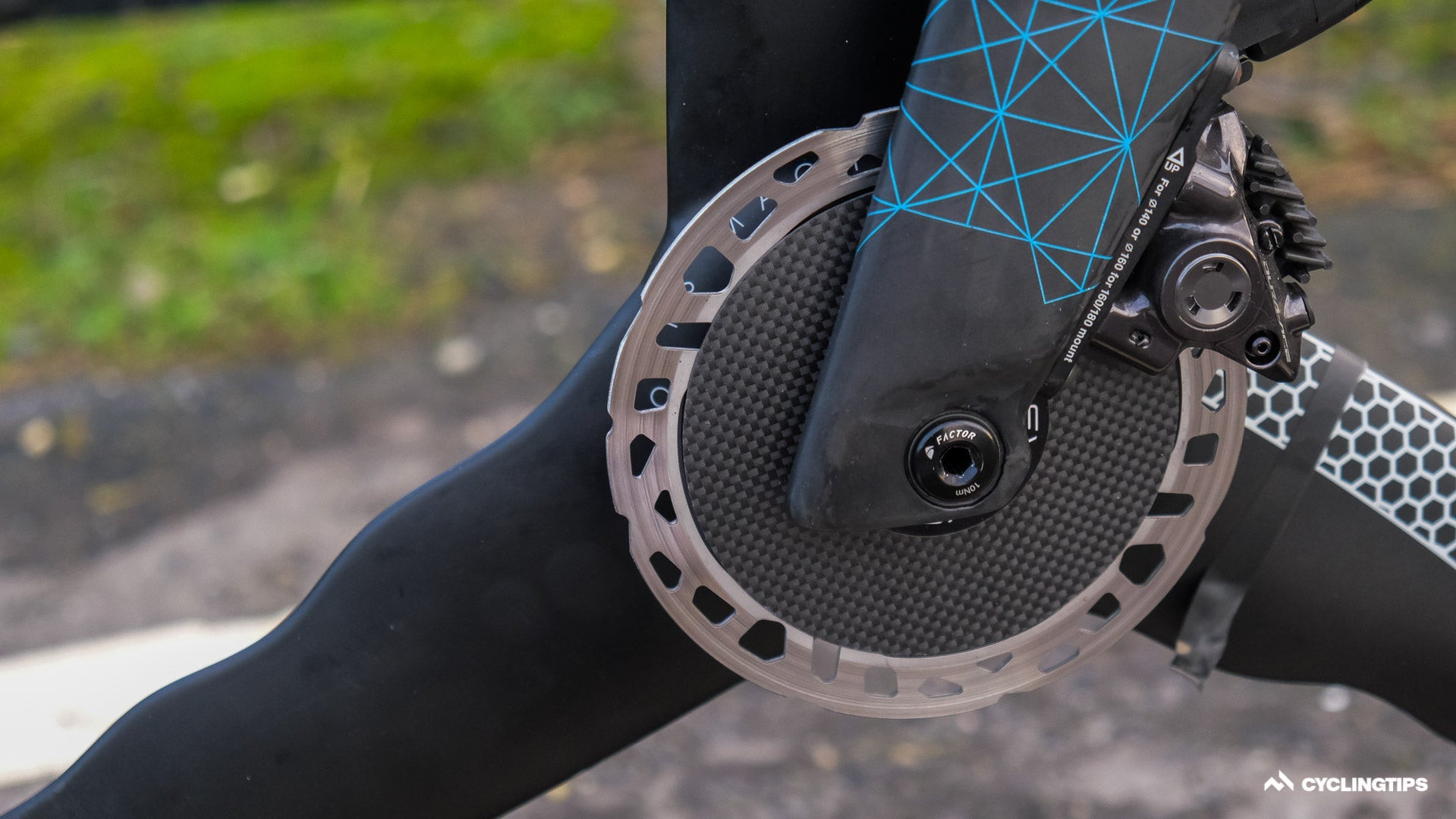 Revolver Aeroto disc rotor fairings on the Factor Hanzo, showcasing marginal gains and aerodynamic detailing
Revolver Aeroto disc rotor fairings on the Factor Hanzo, showcasing marginal gains and aerodynamic detailing
Speaking of marginal gains, the Revolver Aeroto disc rotor fairings exemplify the pursuit of every possible aerodynamic advantage.
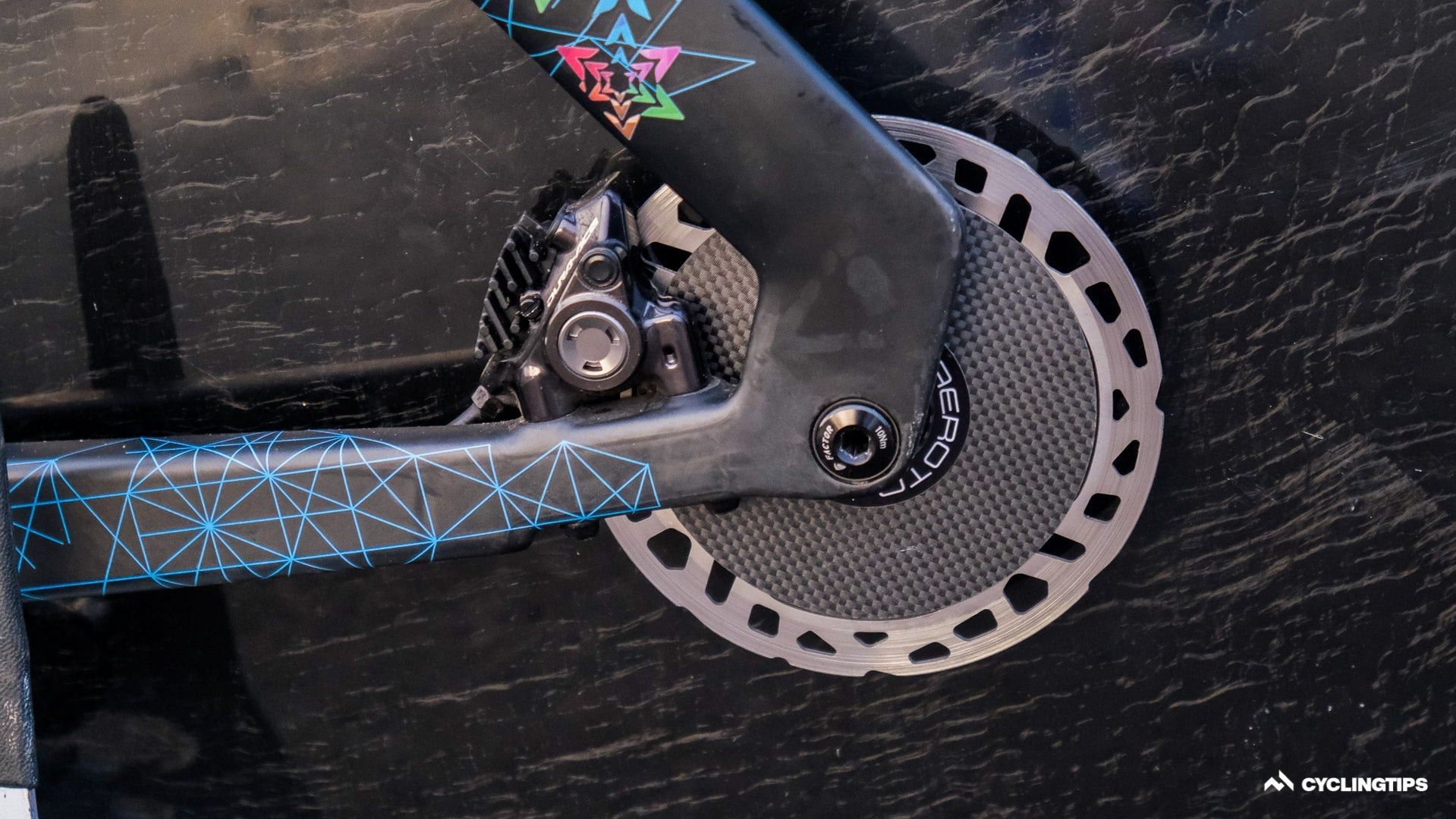 Front and rear Revolver Aeroto carbon fairings on the Factor Hanzo's 140mm rotors, highlighting attention to detail
Front and rear Revolver Aeroto carbon fairings on the Factor Hanzo's 140mm rotors, highlighting attention to detail
Front and rear carbon fairings, even on diminutive 140mm rotors, demonstrate the level of detail considered in this build, where every watt saved counts.
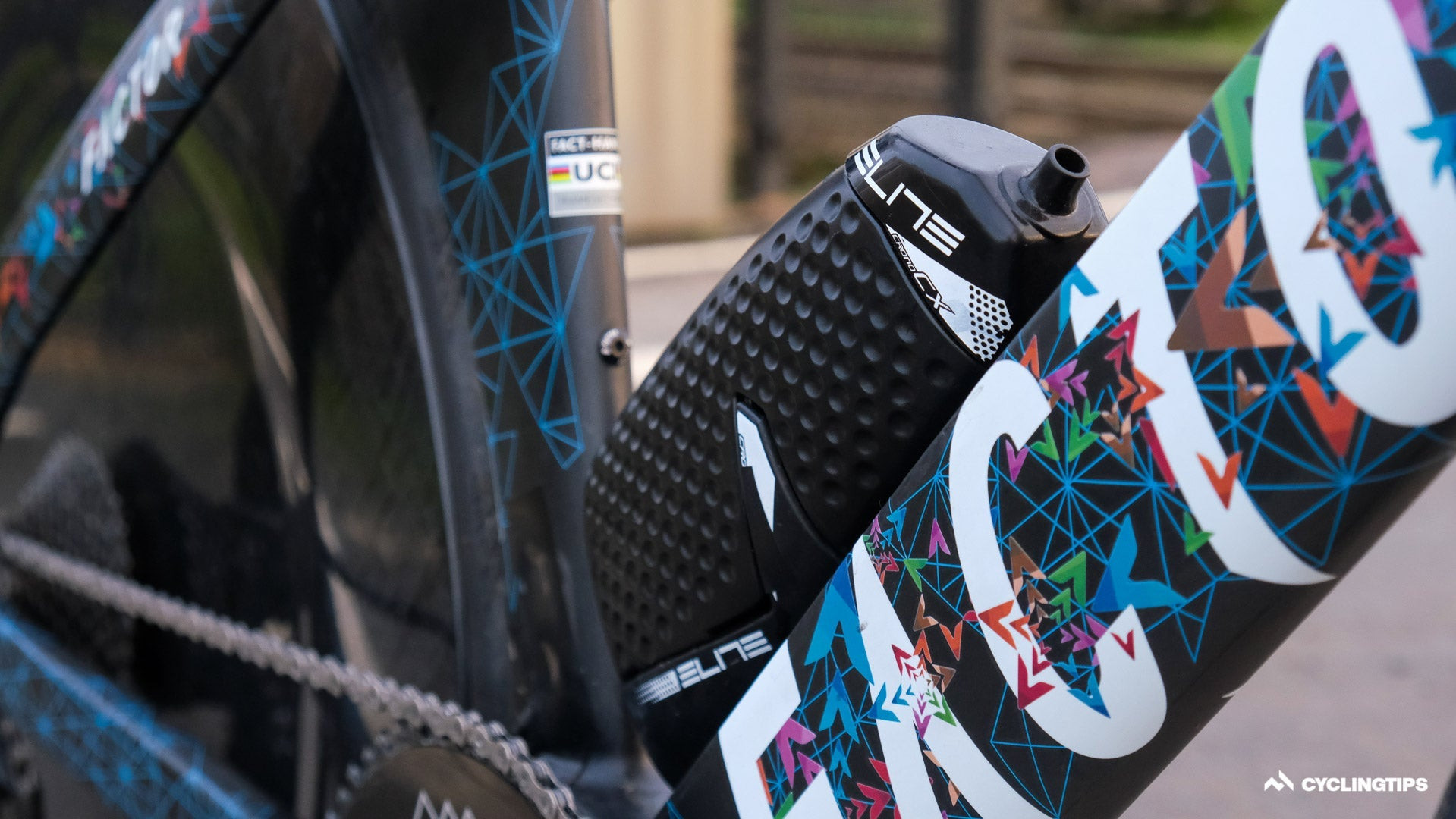 Elite Chrono CX aero bottle and cage on the Factor Hanzo downtube, emphasizing integrated hydration solutions
Elite Chrono CX aero bottle and cage on the Factor Hanzo downtube, emphasizing integrated hydration solutions
Hydration is essential, but aerodynamics are paramount. A stash of Elite Chrono CX aero bottles and cages, originally acquired for an ultra-race, integrates seamlessly with the Hanzo downtube. For non-UCI events, a Camelbak under the skinsuit remains an option, but integrated bottle solutions are preferred for their aerodynamic benefits.
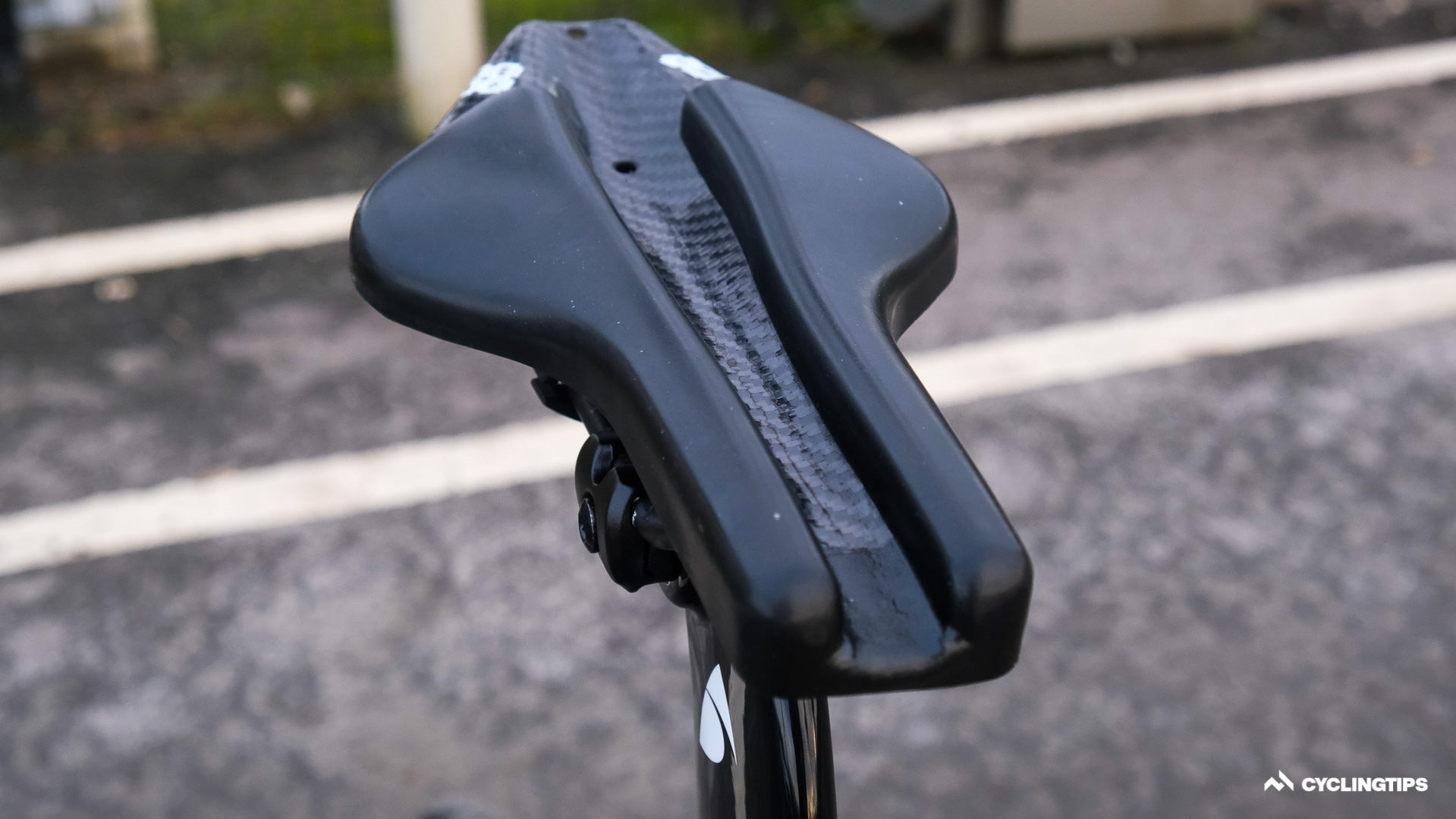 Wove V8 TT saddle on the Factor Hanzo, designed for comfort and aero position maintenance
Wove V8 TT saddle on the Factor Hanzo, designed for comfort and aero position maintenance
Time trial bike comfort is relative; a degree of discomfort is often accepted as a consequence of aerodynamic positioning. Shifting, sliding, and numbness were once considered inevitable. The Wove V8 TT saddle aims to challenge this notion. Colorado-based Wove claims the V8 “will change how you feel about being in the aerobars.” This 140-gram carbon saddle is designed to minimize thigh rubbing and soft tissue pressure in the aero position, while a high-grip material helps riders maintain their position without resorting to extreme measures.
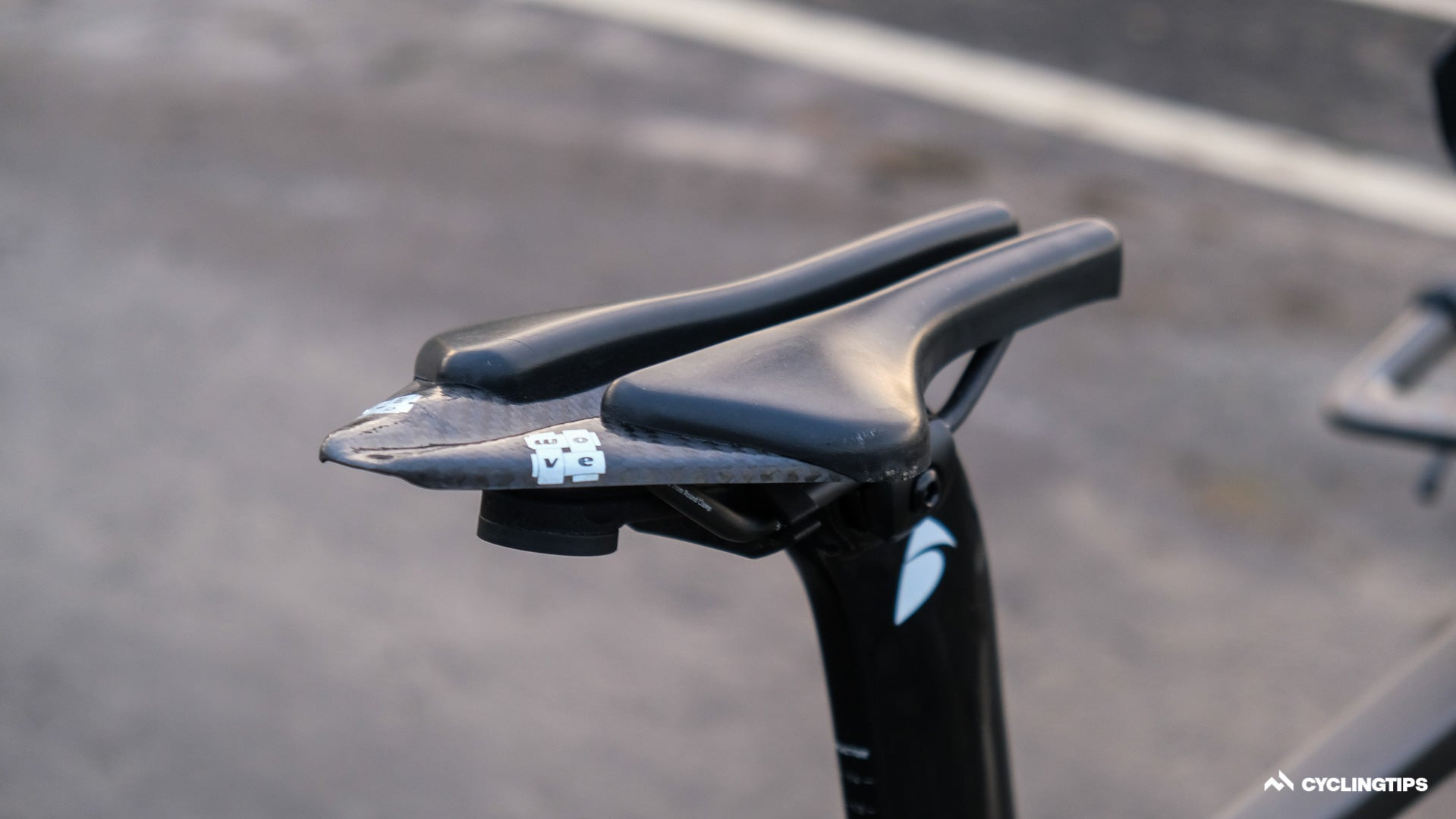 Rear view of the Wove V8 TT saddle, showing its bottle cage mounting points and aerodynamic shape
Rear view of the Wove V8 TT saddle, showing its bottle cage mounting points and aerodynamic shape
The nose of the V8 saddle is longer and narrower than typical TT saddles, while the rear retains sufficient width for riding in an upright position. Rear bottle cage mounts offer the option to carry additional hydration or potentially gain further aerodynamic advantages by smoothing airflow off the rider’s back.
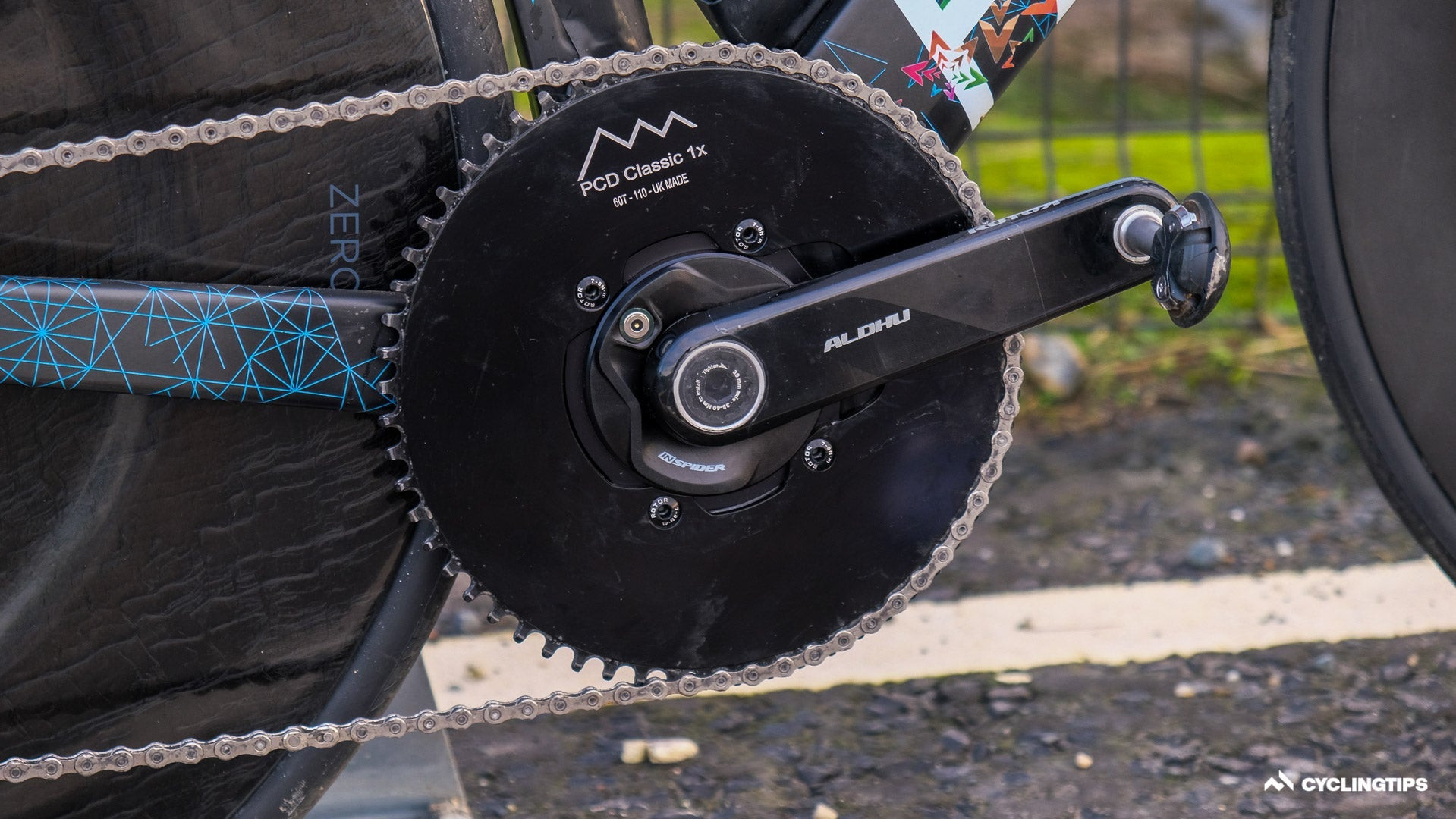 Rotor InSpider power meter and Pyramid Cycle Design 60-tooth chainring on the Factor Hanzo, emphasizing power data and drivetrain efficiency
Rotor InSpider power meter and Pyramid Cycle Design 60-tooth chainring on the Factor Hanzo, emphasizing power data and drivetrain efficiency
Unsurprisingly, a power meter is integrated into this build. Specifically, the Rotor InSpider power meter mounted to 170mm Rotor Aldhu cranks provides crucial performance data.
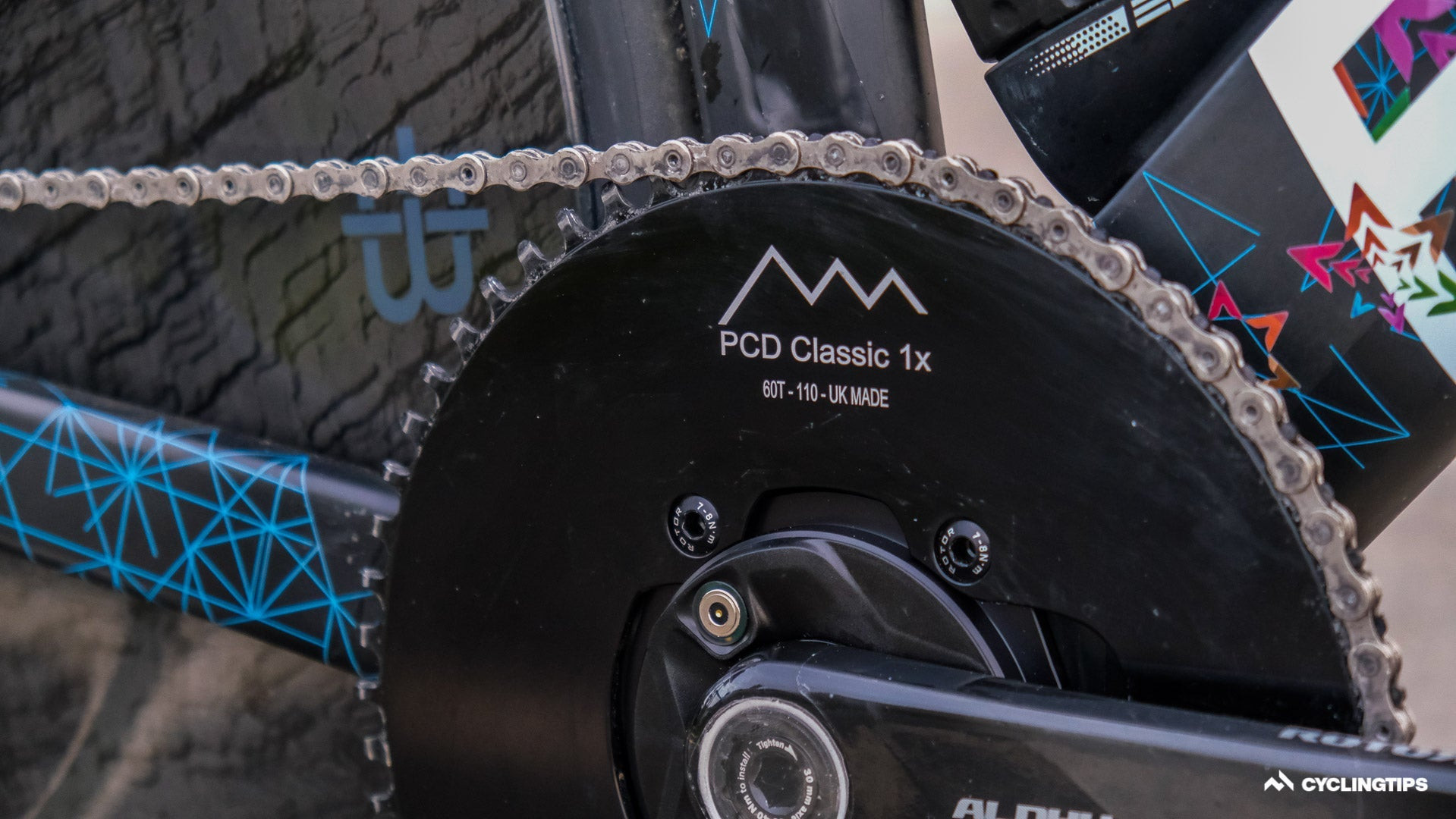 Pyramid Cycle Design 60-tooth chainring detail, showcasing its intricate design and aerodynamic profile
Pyramid Cycle Design 60-tooth chainring detail, showcasing its intricate design and aerodynamic profile
“Go big or go home” is the motto for the drivetrain, featuring a massive 60-tooth chainring from Pyramid Cycle Design. These aluminum narrow-wide TT rings boast an intricate design so secure that a chain catcher is unnecessary. The wider 4mm thick chainrings are designed to better match the chain width, improving aerodynamic interaction. And, yes, it’s a 60-tooth chainring! The chain is treated with Silca Secret Hot Melt wax, with a dedicated Silca pre-treated chain reserved for race day.
 Speedplay Aero pedals on the Factor Hanzo, highlighting time trial specific pedal choice
Speedplay Aero pedals on the Factor Hanzo, highlighting time trial specific pedal choice
Speedplay Aero pedals, the preferred choice for time trial connoisseurs, complete the connection between rider and machine.
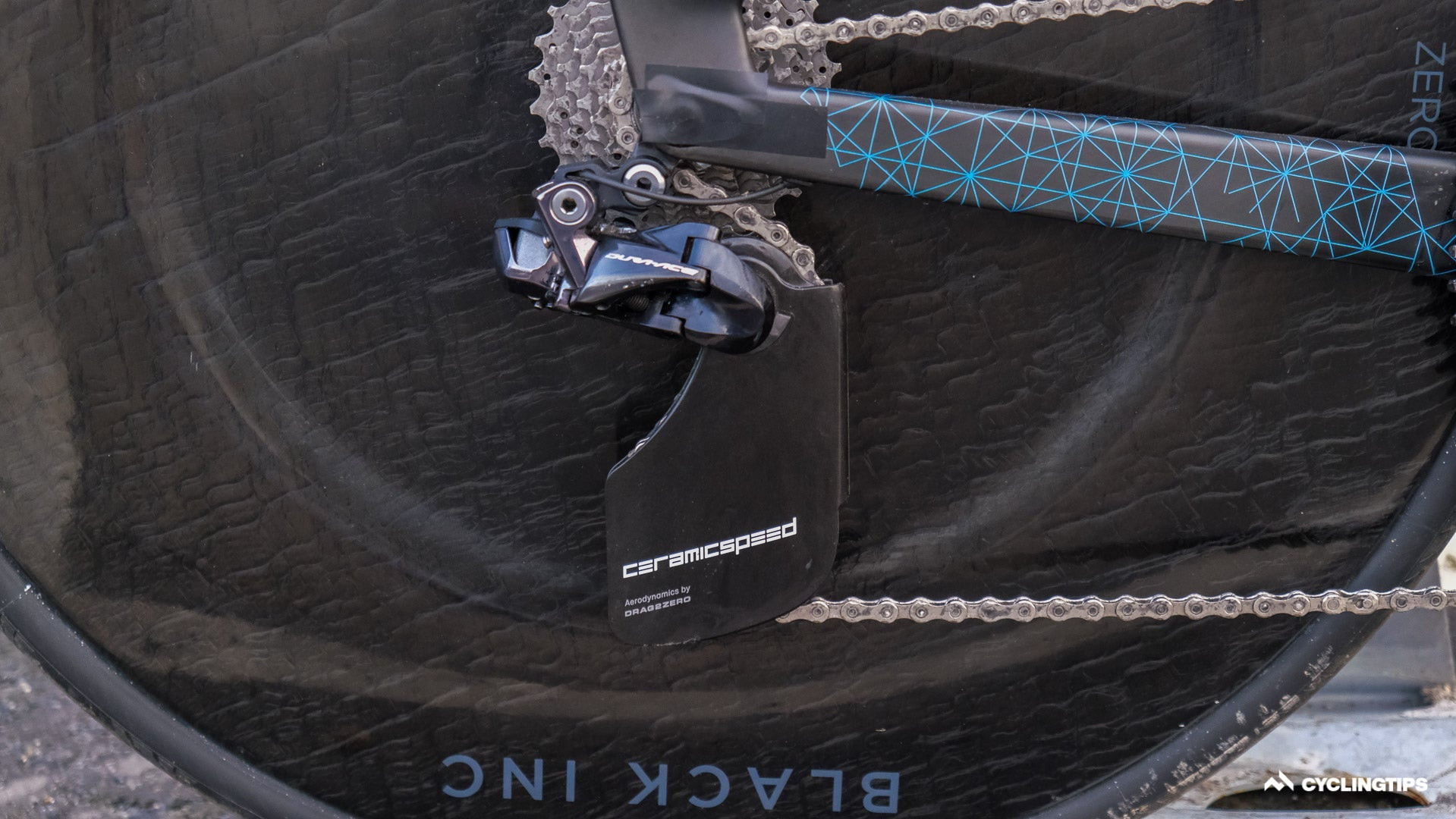 CeramicSpeed OSPW Aero system on the Factor Hanzo, discussing marginal gains and aerodynamic pulley design
CeramicSpeed OSPW Aero system on the Factor Hanzo, discussing marginal gains and aerodynamic pulley design
Speaking of aerodynamic adaptations to standard components, the CeramicSpeed OSPW Aero system is arguably the most debated component on this build. Depending on rider position, this aerodynamic pulley system is either a gift from the time trialing gods, incorporating the efficiency gains of oversized pulley wheels without the associated aero drag penalty, or simply another set of derailleur pulleys. For this build, we firmly lean towards the “time trialing gods gift” perspective.
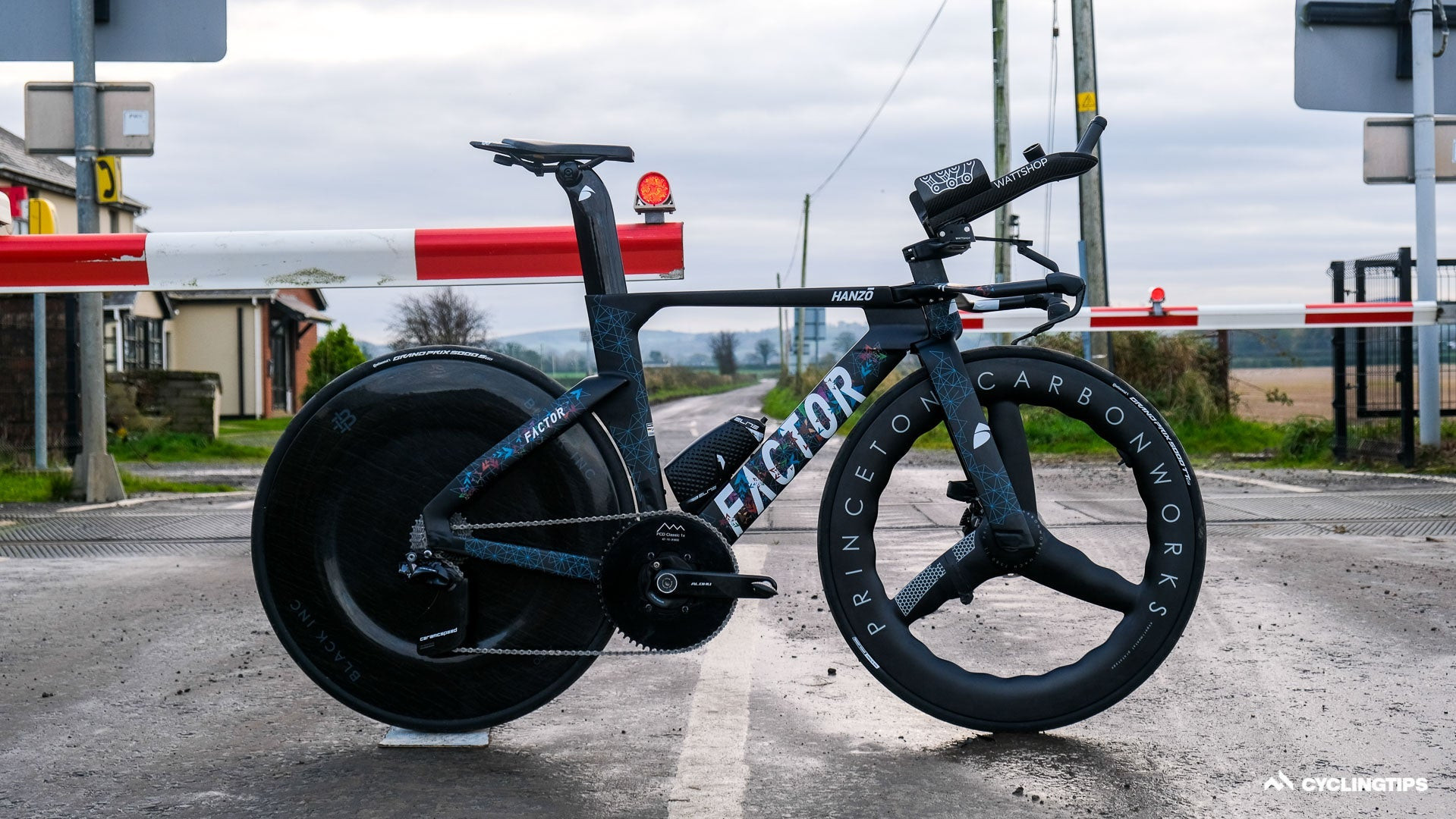 Complete Factor Hanzo time trial bike build, representing the ongoing pursuit of speed and marginal gains
Complete Factor Hanzo time trial bike build, representing the ongoing pursuit of speed and marginal gains
This build isn’t the final word, but rather a chapter in the ongoing story. The relentless pursuit of time trial technology and marginal gains never truly ends.
